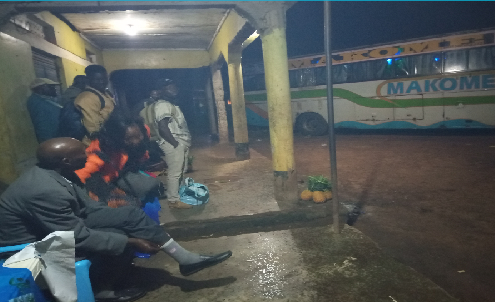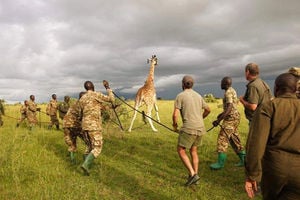
Passengers wait at Kamdini Trading Centre to be transported across Karuma Bridge last Saturday. PHOTO | EMMY DANIEL OJARA
The ongoing repairs on the Karuma Bridge have doubled the costs and travel time for passengers, leaving many in distress.
Transport fares have surged from Shs25,000 to between Shs35,000 and Shs40,000, depending on the bus company, while what used to be a five-hour journey now stretches to at least 10 hours.
The most challenging part of the journey is the stretch between Karuma Town Council in Kiryandongo District and Kamdini Trading Centre in Oyam District, a distance of about 20 kilometres.
As the lifeline connecting northern Uganda to the rest of the country, the Karuma Bridge has become a bottleneck, forcing passengers into a frustrating shuffle between buses and smaller vehicles to cross the Nile.
I travelled from Gulu City to Kampala and back at the weekend, witnessing firsthand the challenges passengers face. Travellers from the Acholi, West Nile, and Lango sub-regions are now required to disembark at Kamdini, board smaller vehicles to cross the Karuma Bridge, and then reboard buses waiting on the other side—a process that turns the journey into an ordeal. Travellers from Kampala to three sub-regions are also subjected to the same ordeal.
The small vehicles make at least four trips to ferry passengers from either side to the waiting buses. The same vehicles are meant to transition heaps of goods and luggage on either side. This requires fresh loading and offloading from both ends. On a good day, these delays last at least two hours, but on bad days, passengers and buses spend more than five hours transitioning.
“We ask for your patience; the process might take longer than expected. There are even rumours that the Karuma Bridge will be fully closed in the next two weeks,” the driver of the transitioning van told the passengers.
Among the stranded passengers were disabled individuals, mothers with babies, pregnant women, school children, and the elderly.
Heavy rain added to their misery, as they had no choice but to stand under the verandah, braving the cold and splashing water.
“I’ve suffered a lot in the last two months,” said Mr David Commando, a passenger travelling from Kitgum to Kampala for medical attention.
“I lost my left arm in an accident in 2016 and have an artificial limb. The journey is worse than my condition.”
As the wait continued, the next bus from Kitgum Municipality arrived at midnight. The bus was full of passengers and luggage, and although the occupants were hesitant to disembark in the rain, they were forced to board the waiting drone to transit across the bridge.
“Whether they like it or not, they will come out. This is the new normal. They should just be mindful and save our time. We have suffered a lot on this road. The government should be considerate,’’ remarked a passenger .
Meanwhile, two people were busy offloading luggage from the bus and loading them onto a pick-up truck under poor mechanical condition. The entire process lasted more than five hours. Some passengers were seen dosing, while others sought solace in nearby drinking joints, as luggage soaked in the rain.
Mr Commando, visibly distressed, said: “My brother, what time do you think we will reach? I’m feeling sick, I’m hungry, but I have nothing to eat. This situation is very challenging!”
Another passenger, Ms Margaret Auma, who was travelling to Gulu, expressed her concerns, “I don’t know what I’ll do when I reach Gulu so late at night. My place has no security lights, how will I carry my luggage, I won’t be able to get a boda boda. I am even fearing for my life”.
Some passengers blamed the government and transporters for the ongoing issues.
“I suffered a lot on the road, and I am not happy with what the Ministry of Works and Transport is doing,’’ Ms Fiona Ladwar, a businesswoman, who was travelling to Nwoya District through Gulu City, said.
She added: “Our businesses are highly affected because of this Karuma Bridge. I wonder where our leaders are passing? The government should provide a workable alternative.”
Background
Uganda National Roads Authority closed the 61-year-old Karuma Bridge to heavy vehicles and trucks in May for maintenance.
Heavy vehicles from Kampala to Lango, Acholi and West Nile regions are advised to use alternative routes through Luwero-Kafu, Masindi-Paraa, Murchison Falls National Park, or eastern Uganda via Iganga, Nakalama-Tirinya-Pallisa-Kumi-Soroti-Lira.
However, to save time and cost, many public transporters have opted to use the Gulu-Kampala highway. On July 6, State Minister for Works Musa Ecweru launched the process of repairing the bridge.
The restoration, estimated to cost Shs7 billion, is being carried out by the NEC UPDF and China Railway Seventh Group (CRSG).






